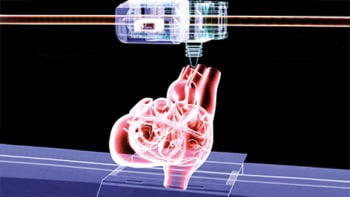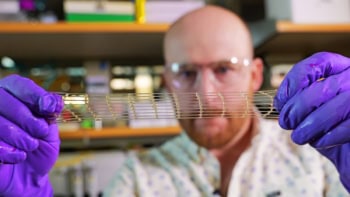
Single-layer cell cultures are widely used as an alternative to animal models for investigating the effects of drugs on the brain. But the advantages that such 2D models have in terms of simplicity and accessibility are balanced by some significant shortcomings. Neural networks in 2D cultures respond differently to stimuli compared with those in the 3D physiological structures that they aim to emulate. Cells in 2D cultures also remain viable for just a short time, as the nutrient medium cannot penetrate to the culture’s interior.
To address these problems, researchers in China and the US have demonstrated a 3D tissue construct that sustains a population of neuronal cells for four weeks. The team used a cell-laden bioink to print a stack of three grid-shaped layers on an array of electrodes. Spaces between and within each layer allowed nutrients to reach the cells, while the electrode array measured the cells’ electrophysiological signals. Such constructs reproduce in vivo neural circuits more accurately and over much longer periods than 2D cell cultures, making them a better model for drug testing and studying the dynamics of neural networks.
To fabricate the 3D model, Yu Song, Ting Zhang and colleagues, at the Biomanufacturing and Rapid Forming Technology Key Laboratory of Beijing at Tsinghua University, suspended rat neuronal cells in a solution of gelatin, alginate and fibrinogen. With the right combination of nozzle diameter and flow rate, they found that 85% of cells in the bioink survived the printing process. The researchers also varied the proportion of bioink components so that the structure that they built – a stack of three square grids, each 0.5 mm thick and 8 mm across – had mechanical properties similar to those of living brain tissue.

A week after printing, nearly all of the cells in the structure were still alive and had started to extend neurites to form a network. A 2D control sample at the same point in time had already lost more than a quarter of its cells. The rate of cell death in the 2D culture continued steadily until the end of the experiment four weeks after printing, at which point less than 25% of its cells were still alive. In the 3D structure, in contrast, more than three-quarters of cells survived to the final measurement.
After cultivating the cells for four weeks, Song and colleagues quantified the neural activity in the two cultures by measuring excitatory postsynaptic potentials (EPSPs). They triggered and detected these electrical signals using a 4 × 4 array of electrodes that lay under each culture. The amplitude of the EPSPs in the 3D structure was larger than in the 2D culture, which the researchers attribute to the printed construct’s greater proportion of surviving cells and their better connectivity.
These EPSPs dropped to zero when the team perfused the 3D construct with tetrodotoxin (TTX), a neurotoxin that inhibits the transmission of sodium ions across cell membranes. The speed with which TTX spread through the culture and shut down the cells’ activity showed that the construct is highly sensitive to the effects of such substances, indicating its suitability as a model for drug-screening applications.
“Our ongoing work includes studying how neuro drugs with different molecular structures diffuse at different speeds in our printed models, and administering electrophysiological stimulation and/or pentylenetetrazole to our models to study epilepsy,” says Wei Sun, director of the Biomanufacturing Center at Tsinghua University. “We are also interested in printing stem cells to build a brain-like model to study neurodevelopment, and integrating the printed brain-like models with microfludics to build a ‘brain-on-a-chip’ device.”
Full details of the work are reported in Biofabrication.



